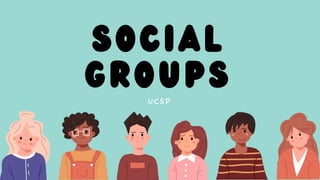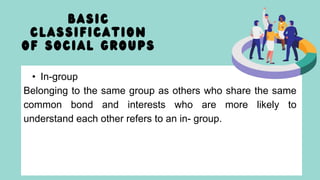Social-Groups.pptx
- 3. Group
- 4. âĒ Primary Groups Basic Classification of Social Groups
- 5. Example
- 6. âĒ Secondary Groups Secondary relationships involve weak emotional ties and little personal knowledge of one another. In contrast to primary groups, secondary groups donât have the goal of maintaining and developing the relationships themselves. These groups are based on usual or habitual interests or affairs. It includes groups in which one exchanges explicit commodities, such as labor for wages, services for payments, and such. Basic Classification of Social Groups
- 7. Example
- 8. âĒ In-group Belonging to the same group as others who share the same common bond and interests who are more likely to understand each other refers to an in- group. Basic Classification of Social Groups
- 9. Example
- 10. âĒ Out-group Those who do not belong to the in-group are part of the out- group, which exist in the perceptions of the in-group members and takes on social reality as a result of behavior by in-group members who use the out group as a negative point of reference. Basic Classification of Social Groups
- 11. âĒ Reference Groups A reference group is a collection of people that we use as a standard of comparison for ourselves regardless of whether we are part of that group. We rely on reference groups to understand social norms, which then shape our values, ideas, behavior, and appearance. This means that we also use them to evaluate the relative worth, desirability, or appropriateness of these things. Basic Classification of Social Groups
- 12. Example
- 13. âĒ Network A network is a collection of people tied together by a specific pattern of connections. They can be characterized by the number of people involved, as in the dyad (by twos) and triad (by threes), but also in terms of their structures (who is connected to whom) and functions (what flows across ties). Basic Classification of Social Groups
- 14. âĒ âĒ
- 15. Any Questions?














